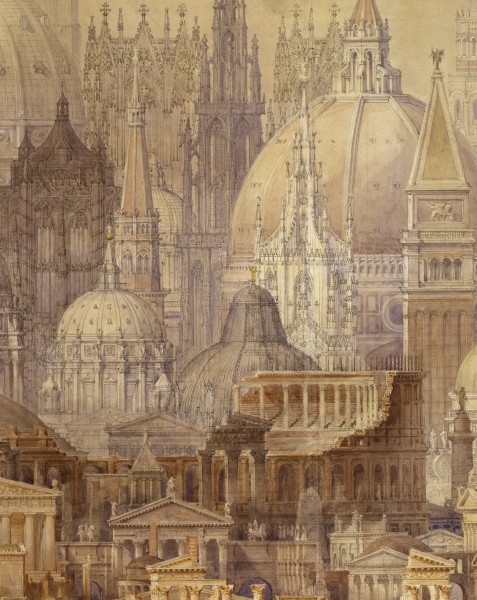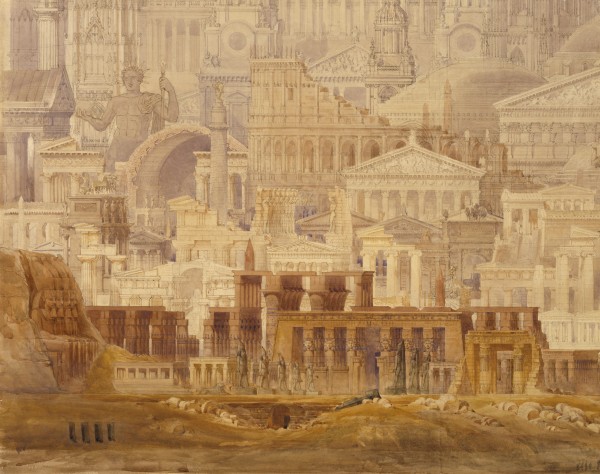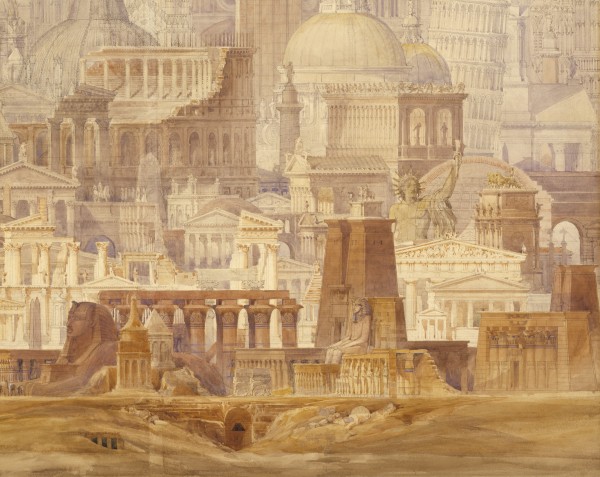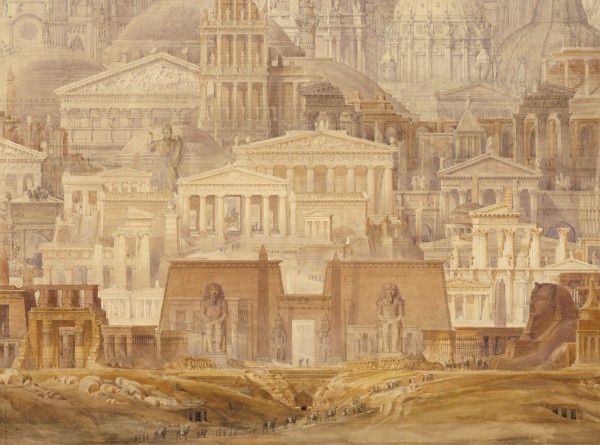The Immersive Future of the Architectural Monograph
 [Image: A Tribute to Sir Christopher Wren (1838) by Charles Robert Cockerell].
[Image: A Tribute to Sir Christopher Wren (1838) by Charles Robert Cockerell].Yesterday in the architecture galleries of the V&A, I found myself looking at a painting by Charles Robert Cockerell called A Tribute to Christopher Wren, from 1838.
The image is a spatially overwhelming lamination of various buildings all designed by the legendary English architect; in a way, it's an early predecessor of today's total city renderings by firms like Foster & Partners and OMA: a complete metropolis designed in one fell swoop by a master architect.
What first came to mind, though, when seeing Cockerell's image, was something that I've mentioned on the blog before – as recently as in the interview with Jim Rossignol – which is that the era of the architectural monograph is over: perhaps we will soon enter the age of the architectural videogame.
In other words, what if Charles Robert Cockerell had not been a painter at all, but a senior games designer at Electronic Arts? His "tribute to Christopher Wren" would thus have looked quite different.
The architect's buildings would still be visually represented, all standing in the same place, but thanks to the effects of immersive digital media and not the intensely beautiful but nonetheless materially obsolete techniques of a different phase of art history.
Might we yet see, for instance, A Tribute to Sir John Soane, complete with scenes of zombie warfare beneath the arches of ruined bank halls, released by Joseph Gandy Designs Corporation™?
When it comes time to release a major monograph, MVRDV instead releases a videogame.
Bjarke Ingels has already released a comic book – the game, as another narrative medium, as simply another option for architectural publishing, can't be far off.
Learning about the buildings of Erich Mendelsohn... by hurling virtual grenades at them.
 [Image: The Professor's Dream (1848) by Charles Robert Cockerell, courtesy of the Royal Academy of Arts].
[Image: The Professor's Dream (1848) by Charles Robert Cockerell, courtesy of the Royal Academy of Arts].Until then, here are some more or less unrelated close-up views of another of Cockerell's works, the otherworldly pyramids, domes, and steeples from The Professor's Dream (1848), courtesy of the Royal Academy of Arts.




 [Images: The Professor's Dream (1848), and several details thereof, by Charles Robert Cockerell, courtesy of the Royal Academy of Arts; say what you like about pastiche, but a part of me wishes that all cities looked like this].
[Images: The Professor's Dream (1848), and several details thereof, by Charles Robert Cockerell, courtesy of the Royal Academy of Arts; say what you like about pastiche, but a part of me wishes that all cities looked like this].Gaming our way through the future of architectural history.





Comments are moderated.
If it's not spam, it will appear here shortly!
it seems like a video game could take on the role of a traditional arch rendering or maybe something that would be used as a marketing device for a new apartment complex etc. i guess a momograph would work well in video game form. i kind of like it. although at the same time i dont.
Geoff,
Thanks for posting these amazing images. I don't follow the logic of the end of the architectural monograph. Wouldn't such a video game as you describe be a kind of monograph akin to Ingles' comic book? Having just played Left 4 Dead - a kick-ass experience - for the first time last night, I have to say such immersive opportunities are bound to be appropriated for architectural purposes in the near future as you suggest. John Szot recently taught at class at GSAPP that utilized the Unreal Engine, so it is on the way. I guess what I'm getting at is this; a virtual monograph may be comparable to an online portfolio, or pdf document. If there's a more nuanced aspect that I'm missing, please fill me in. Thanks for sharing. Keep up the good work.
I've been thinking about the value of renderings a lot. Reading Looking Backward, Edward Bellamy's 19th-century smash hit socialist utopian novel, I was struck at his lack of descriptions of the future Boston.
In one scene, the narrator (who has woken up in 2000, having fallen asleep in 1887) goes wandering around the city. Yet we read nothing about how the city looks. The landscape is completely internal and psychological. In any movie or game or rendering, it would be nearly impossible to sidestep those details. In other words, you'd NEED some model of the future. Just by virtue of the medium, there'd be some kind of landscape to explore.
I don't think that renderings improve quality of thinking, but they do require a thoroughness of vision that few writers ever approach (and for good reason, who'd want to read a description of the Bioshock world as detailed as the world itself?). And that's worthwhile.
I agree with you that as rendering engines employed in gaming systems continue to get more complex and faster, there comes a point where exploring the environment takes over. I remember being an architect in California around the time George Lucas was considering revisions to the original films - and he was hiring architects to help him make the digital cities as realistic as possible.
Today, I am increasing fascinated by sites like Second Life which have very real architectural implications. Developers can digitally take clients through a house before construction has even begun, historic preservationists can recreate buildings lost to demolition. Architects can walk clients through full size versions of their portfolios. I think all of this will continue to get better as technology continues to get faster and ceaper.
At the Paul Rudolph Foundation we are looking into ways to use this technology to promote preservation of Paul Rudolph's work through creating digital versions of his unbuilt projects in SecondLife and adding digital versions of his buildings to Google Earth.
Great post and thanks!
Kelvin Dickinson
The Paul Rudolph Foundation
Post a Comment